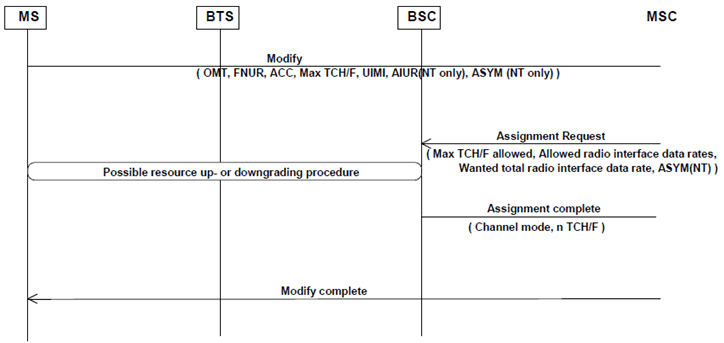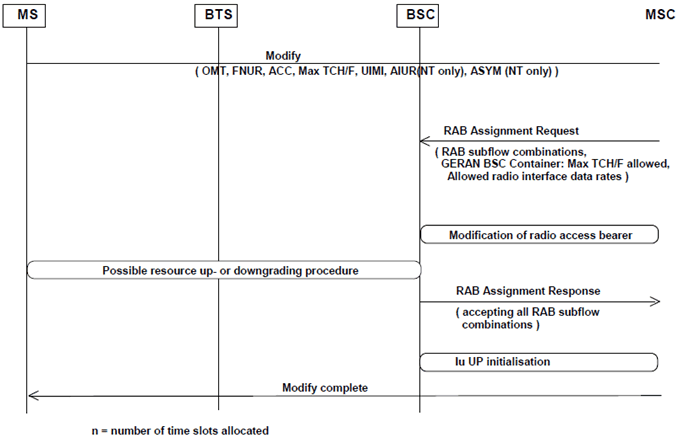Content for TS 23.034 Word version: 18.0.0
5.2.4 User initiated service level up- and downgrading (A/Gb mode)
5.2.4a User initiated service level up- and downgrading (GERAN Iu mode)
5.2.5 Link adaptation for ECSD
5.2.6 Start of ciphering
5.2.4 User initiated service level up- and downgrading (A/Gb mode) p. 23
Figure 9 depicts the procedures for a successful user initiated service level up- and downgrading for on going HSCSD call in A/Gb mode.
During a HSCSD call the user may request, if so indicated in the call setup, the network to change the current maximum number of traffic channels and air interface user rate parameters and/or channel coding asymmetry preference. This is done by using the CC User initiated service level up- and downgrading procedure.
If network allows the modification, the resulting new parameters are forwarded to BSC and the radio interface resources may be adjusted accordingly. The resource upgrading or downgrading is done separately from the change in HSCSD parameters. However, if a contradiction between the new parameters and the used air interface resources exists, the resource downgrading may be needed before the network acknowledges the new parameters.
The user initiated service level up- and downgrading is applicable in non-transparent mode connections, only.

Figure 9: User initiated service level up- and downgrading in A/Gb mode
(⇒ copy of original 3GPP image)
(⇒ copy of original 3GPP image)
5.2.4a User initiated service level up- and downgrading (GERAN Iu mode) |R5| p. 24
Figure 9a depicts the procedures for a successful user initiated service level up- and downgrading for on going HSCSD call in GERAN Iu mode.
The user initiated service level up- and downgrading is applicable in non-transparent mode connections, only.

Figure 9a: User initiated service level up- and downgrading in GERAN Iu mode
(⇒ copy of original 3GPP image)
(⇒ copy of original 3GPP image)
5.2.5 Link adaptation for ECSD p. 25
Link adaptation for ECSD particularly in high data rate call becomes essential in order to provide good enough service over large coverage areas. In A/Gb mode, signalling for link adaptation between channel coding schemes in 8-PSK modulation and between GMSK and 8-PSK coding schemes is done using existing signalling mechanisms, i.e. RR Channel Mode Modify procedure, intracell handover, etc. In performing link adaption between 8-PSK modulated channels, the normal Channel Mode (or the assignment or the intra-cell HO procedure) should be used and in case of link adaptation between 8-PSK modulated channels and GMSK modulated channels the assignment procedure or the intra-cell handover should be used.
In GERAN Iu mode, the Radio bearer reconfiguration procedure is used for link adaptation.
5.2.6 Start of ciphering p. 25
In A/Gb mode, in order to start ciphering, the RR Encryption procedure is controlled by the main signalling link, only. The encryption information for secondary HSCSD channel is forwarded to the corresponding TCH/F in initial channel activation or later in the channel reactivation or Mode modify message.
The change of ciphering modes for separate channels within the HSCSD connection might not be perfectly synchronized.
In GERAN Iu mode, the Security mode control procedure is used to start ciphering (see TS 44.118).